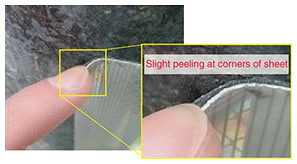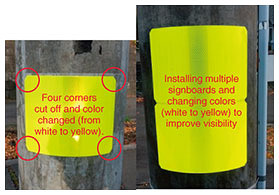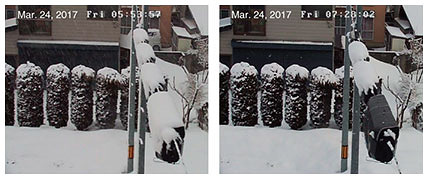 |
|||
|
|
|||
|
Practical Field Information about Telecommunication Technologies Vol. 16, No. 12, pp. 42–46, Dec. 2018. https://doi.org/10.53829/ntr201812pf1 Initiatives Targeting Snow Damage to Communication FacilitiesAbstractMany communication facilities installed outdoors are continuously exposed to harsh weather including snowfall. This article presents a countermeasure to prevent the bands that secure signboards to utility poles from breaking and a countermeasure to prevent snow from accumulating on overhead equipment. This is the forty-ninth article in a series on telecommunication technologies. Keywords: snow damage, utility pole, closure 1. IntroductionMany communication facilities installed outdoors are continuously exposed to harsh weather including wind, rain, and snowfall. Consequently, many countermeasures to prevent damage caused by such conditions have been implemented. Moreover, in the winter of 2017/18, snowfall in Japan was heavier than that in normal years, and damage due to the heavy snowfall was reported, particularly in northern Japan. Accordingly, concerns about snow damage have increased. In regions with heavy snowfall, NTT facilities are also affected by snow damage, which leads to failures and accidents. The Technical Assistance and Support Center is working on countermeasures to prevent the bands that secure signboards to utility poles from breaking and countermeasures to prevent snow from accumulating on overhead equipment. Both of these phenomena contribute to increases in repair operations and accidents in snowy areas. 1.1 Breakage of bandsUtility pole signboards are installed on utility poles along roads across the country for the purpose of preventing accidents such as vehicles accidentally hitting the utility poles (Fig. 1). The signboards are affixed to the poles with vinyl bands. A common phenomenon that occurs is that one or more of the vinyl bands breaks due to the load of accumulated snow, and the band(s) and/or signboard falls off as a result. This band breakage occurs over a wide region and thus requires a large operation to replace the broken bands. Moreover, if the bands and/or signboards fall off, they might affect passing pedestrians or vehicles, possibly leading to accidents.
1.2 Snow accumulationIn snowy areas, snow accumulates on overhead equipment such as cable closures and cable intersections (Fig. 2). If the snow continues to fall for several days, repeated melting and resolidification will generate lumps of ice, and the risk of those ice lumps falling is a very dangerous one that may lead to traffic accidents resulting in injury or property damage (Fig. 3). Accordingly, maintenance to remove accumulated snow is carried out periodically to prevent such accidents. When workers clear snow in this kind of operation, they must use an aerial platform, the use of which is a major operation.
Details about certain countermeasures against snow damage to utility poles devised by the Technical Assistance and Support Center have previously been introduced [1]. In this issue, two of our initiatives—namely, a countermeasure to prevent breakage of the vinyl bands securing utility pole signboards and a countermeasure to prevent snow from accumulating on overhead equipment—are introduced. 2. Measures to prevent breakage of vinyl bands securing utility pole signboardsIn this section, we describe the problem in detail and explain the proposed countermeasures and the results of field trials. 2.1 Mechanism by which bands breakWe conducted a field trial to confirm the mechanism by which the bands break. In this trial, two patterns of load application by snow accumulation were assumed: (i) the case in which the bands break due to application of a load to the utility pole signboard and (ii) the case in which a load is applied only to the band itself, causing it to break. The aim of the trial was to verify by which pattern (or both) the bands break. During the trial, lasting from December 2015 to April 2016, a countermeasure was applied that involved closing the gap between the utility pole and the utility pole signboard (Fig. 4). This was done to verify the case in which the band broke due to snow loading on the band itself. A countermeasure involving protecting the band with sealants was also applied to verify the case in which the band broke due to snow loading on the utility pole signboard. The trial site used a utility pole placed in a residential area located at the foot of a mountain in a region that receives heavy snowfall. The amount of snowfall in the year of the trial (2016) was about 2.5 m, and the trial site was a location where snowfall and ploughed snow regularly pile up significantly (Fig. 5).
We checked the state of the signboard and band during snowfall and after snow thawing. In the case where the gap between the utility pole and the utility pole signboard was closed by attaching tape, icing and twisting of the band’s fastener and the left/right ends of the band still occurred. These phenomena caused the band to break. Since breaking, sagging, and twisting of the band was confirmed even if the gap between the utility pole and the signboard was closed, it was assumed that sedimentation pressure (pressure caused when snow accumulates and settles in one place) acts directly on the band. The mechanism leading to the band breaking was considered to have three stages: (1) ice building up on the band, (2) generation of sedimentation pressure causing twisting of the band so it distorts outward, and (3) breakage of the band (Fig. 6).
In contrast, in the case where the band was protected with sealants, snow only accumulated on the signboard and the band did not break. 2.2 Proposed countermeasures and field trialsIt became clear that the load is directly applied to the band by sedimentation pressure, so three proposed countermeasures against band breakage (Table 1) were tested in trials from December 2016 to April 2017 (Fig. 7).
When proposed countermeasure (1) was applied, certain effects of reducing sedimentation pressure were confirmed, and no band breakage was observed in any of the five samples. However, loosening and twisting of the band as well as peeling of part of the standard sealant were observed. This result is thought to be due to the fact that working with standard sealant is somewhat difficult, and thus it is not easy to apply it evenly. It is therefore conceivable that in the future, the standard sealant will peel off, and the band will subsequently break. In the case of proposed countermeasure (2), although no twisting or breaking of the band was seen, the band did loosen. It is therefore also conceivable that the band might break in the future. With proposed countermeasure (3), some of the trial samples showed slight peeling at the four corners of the sheet (Fig. 8), but the adhesiveness of the sheet was found to be basically satisfactory, and it was easy to apply the sheet evenly, with the correct alignment and without puckering or air bubbles.
Since no problem concerning adhesiveness was found, and the sheet was easy to apply, an additional verification of countermeasure (3) was conducted. We are currently evaluating whether cutting off the four corners of the sheet before applying it will prevent the peeling at the corners. In addition, to achieve stable sheet visibility and improve adhesion quality, an on-site trial of an improved version of this countermeasure (3), namely, a signboard with adhesive backing is continuing. In this trial, in addition to the adhesiveness and visibility of the signboard, the size and color suitable for installation are being evaluated (Fig. 9). Similar trials were also carried out on steel-pipe columns.
3. Countermeasure to prevent snow accumulation on overhead equipmentIt is difficult to avoid snow accumulation on overhead equipment in snowy areas, but it is thought that if the snow falls off harmlessly before it turns into a lump of ice, accidental damage can be prevented. Therefore, an initial test was carried out to evaluate a method of prompting snow to fall from overhead equipment after it accumulates during snowfall. A water-repellent sheet was attached to the top of a cable closure, and the closure was observed to determine if the sheet caused the snow to fall off rather than to accumulate (Fig. 10). The test result revealed that by attaching the water-repellent sheet to the top of the closure, the snow that accumulates on that closure was eliminated in a short time (seen in the photo on the right), so that snow was prevented from becoming a lump of ice. Investigations will continue to monitor aging deterioration of the sheet and other factors in order to verify the effectiveness of this countermeasure.
4. Concluding remarksThese trials were conducted with the assistance of the NTT EAST-Tohoku, Aomori Branch, Facilities Division, Aomori Service Center; NTT EAST-Tohoku, Yamagata Branch, Facilities Division, Yamagata Service Center; and NTT EAST-Kanshinetsu, Nagano Branch, Facilities Division. More information will be reported as it becomes available. Reference
|
|||



















